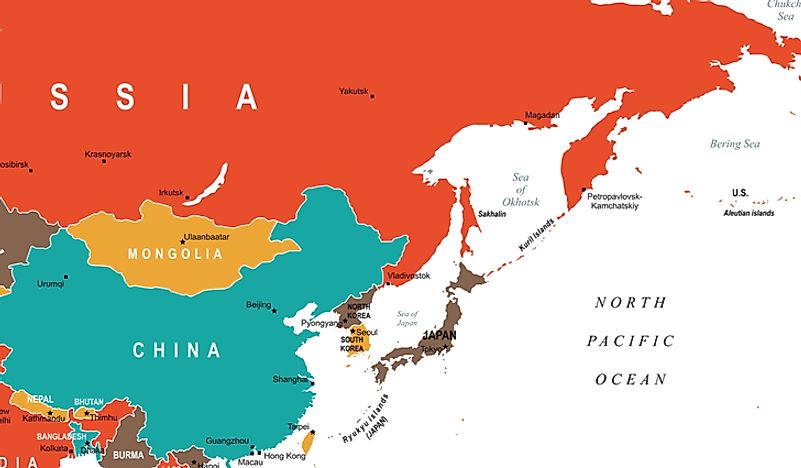Which Countries Are Part of East Asia?

- East Asia is the most populous region in the world.
- China is the most populous country in East Asia, and the world, with more than 1.4 billion people.
- Macao has East Asia's smallest population, but it is the most densely populated territory on Earth.
- The East Asian state of Mongolia gave birth to the Mongol Empire, the largest empire in human history by area.
East Asia is the most populous region in the world. It contains China, which has the biggest population in the world at more than 1.4 billion, and the second-biggest economy in the world in terms of GDP, rivalled only by the United States. East Asia also includes Japan, the world’s third-biggest economy, and a population of 126 million. The rest of the region’s states and territories have smaller populations, but some of them, including Hong Kong, South Korea, and Taiwan, are known as Asian Tigers due to their significant economic growth in recent history. Here are some short descriptions of the countries and territories in East Asia.

Macao
Macao (also spelled Macau) was once a Portuguese colony but is now a Special Administrative Region (SAR) of the People’s Republic of China. The territory’s population is just over 649,000, but it is also the most densely populated territory on Earth. Remnants of its Portuguese colonial past still remain, including some buildings that are collectively designated as a UNESCO world heritage site. The territory’s economy is based mainly on tourism and gambling. In fact, Macao is home to five of the world’s largest casinos.
Mongolia
Mongolia is the country that gave birth to the mighty Mongol Empire, the largest empire in history by area. Today’s Mongolia is a sparsely populated country of just over 3.2 million people. Some Mongolians still observe a very traditional lifestyle, living in tent-like dwellings, known as yurts, and farming or herding for subsistence.
Hong Kong
Once a British colony, Hong Kong’s exponential economic growth began in the 1970s. Since then, it has remained an economic powerhouse. In 1997, Hong Kong was returned to Chinese sovereignty and became a Special Administrative Region of the People’s Republic of China, giving it some autonomy over its affairs. Recently, however, China has set about reducing Hong Kong’s political autonomy, drawing condemnation from both the local population and the international community.

Taiwan
The island off the coast of mainland China is another of the so-called Asian Tiger economies. Although Taiwan has de facto independence, very few countries recognize it as an independent state, mostly for fear of damaging relations with the People’s Republic of China, which views Taiwan as a renegade province. In fact, China has repeatedly warned that it will use force to take the island back, if necessary. For this reason, Taiwan has had to maintain a formidable military force with much of its military hardware coming from the US.
North Korea
North Korea is arguably the most isolated state in the entire world. It has been a communist dictatorship since the years following World War II. The people of North Korea have little to no contact with the outside world. No political opposition is allowed. The economy of North Korea is almost completely stagnant. In fact, there have been reports of starvation in the country, which may be one of the reasons why some of its people have tried to leave the country, many defecting to North Korea’s archenemy, South Korea.
South Korea
In contrast to the impoverished North, South Korea has both a vibrant economy and a vibrant democracy. Since the Korean War of the early 1950s, South Korea has experienced rapid economic growth, making it one of the so-called Asian Tigers. It has had to be vigilant, however, in the face of threats from neighboring North Korea, which has threatened to reunify the Korean Peninsula by force. Hence, South Korea has maintained a strong military alliance with the US, which still has thousands of troops stationed there.

Japan
Unlike much of Asia, Japan managed to avoid European colonial expansion. Indeed, by the early 20th century, the country had built a vast empire of its own. Its imperialist expansion ultimately brought it into conflict with the Western powers, including the US, which fought and defeated Japanese imperial forces in World War II. But after the war, Japan built a new empire—an economic empire, that is. The country has become an extraordinary economic power, giving the world household names like Toyota and Sony. Japan is also home to the world’s oldest monarchy, which dates as far back as the sixth century BCE.
China
Chinese civilization is among the oldest in the world. China has been a center of innovation and learning since ancient times. It was the Middle Kingdom that gave the world many inventions that we now take for granted, including paper, gunpowder, the compass, and even alcohol. China now has the world’s largest population, at more than 1.4 billion. The country’s population is quite a multicultural society, composed of several different ethnic groups, including the Han Chinese (the country’s majority population), the Uyghurs, Manchus, Tibetans, and various other groups. What was once a largely agrarian society has emerged into the world’s second-largest economy. Most of its rapid growth has taken place under the guise of what China's communist regime calls, “socialism with Chinese characteristics,” which is essentially a move towards free-market capitalism. China has also expanded its military and foreign influence, which has been a cause for concern among other countries, especially its neighbors.
Which Countries Are Part of East Asia?
| Rank | Country | Population (2020) |
|---|---|---|
| 1 | China | 1,439,323,776 |
| 2 | Japan | 126,476,461 |
| 3 | South Korea | 51,269,185 |
| 4 | North Korea | 25,778,816 |
| 5 | Taiwan | 23,816,775 |
| 6 | Hong Kong | 7,496,981 |
| 7 | Mongolia | 3,278,290 |
| 8 | Macao | 649,335 |











